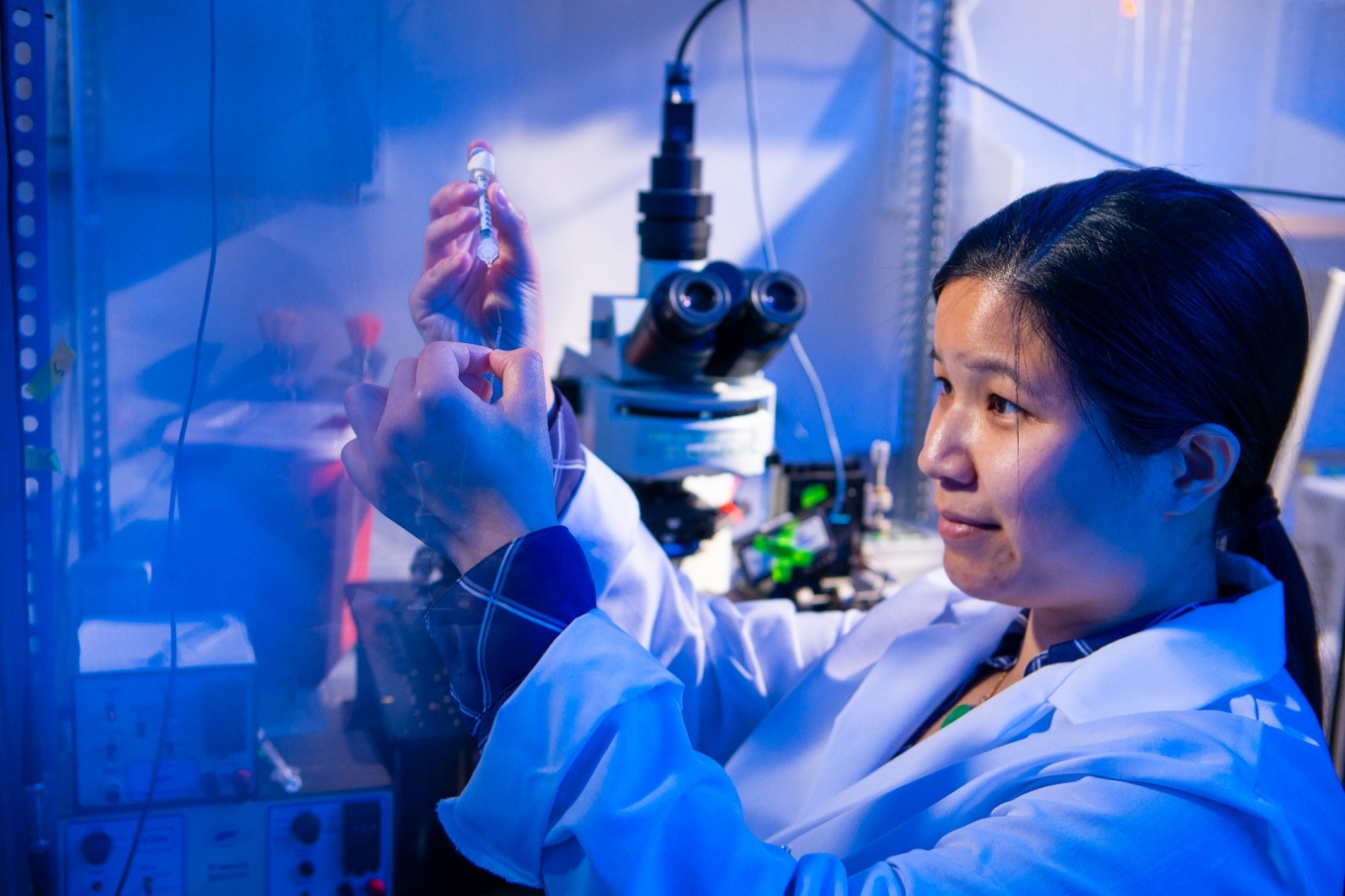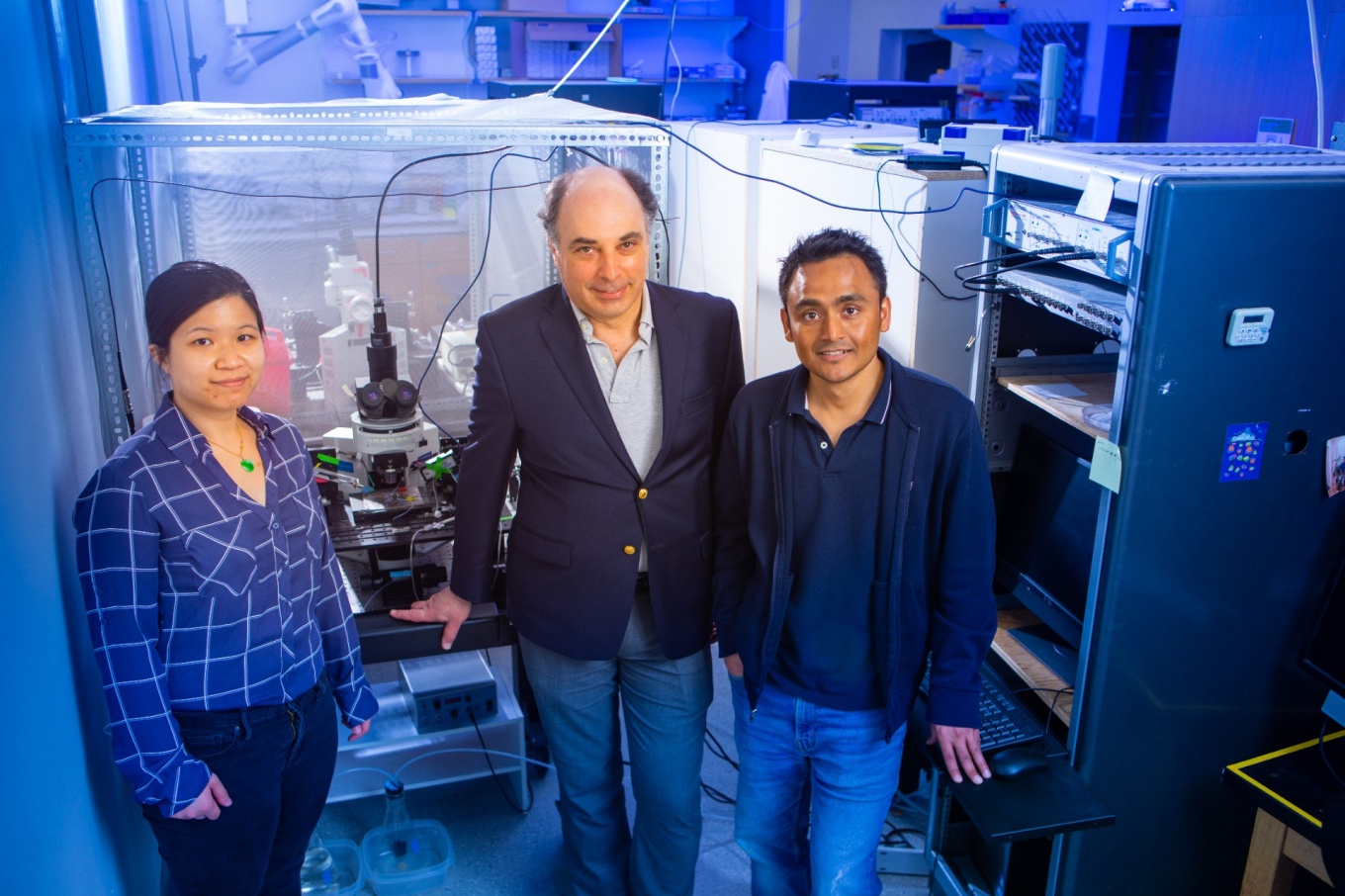Research News
Biochemists use proteins to change how neurons communicate

Researcher Nicole Wong was co-first author of the new study in Nature Communications. Wong worked on the study as a UB PhD student in biological sciences and is now a postdoctoral researcher in biology at Brandeis University. Photo: Douglas Levere
By ANNE MANNING and CHARLOTTE HSU
Published June 22, 2022
As you’re reading this sentence, cells in your brain are sending rapid-fire electrical signals between each other, transmitting information. They’re doing so via tiny, specialized junctions between them called synapses.
Synapses lie between cells called neurons that are found in the brain and other areas of the nervous system, and these junctions can take two main forms: excitatory or inhibitory.
The exact mechanisms by which these structures are generated remain unclear. But scientists have uncovered a major insight into this question by showing that the chemicals neurons release can guide which kinds of synapses form between cells.
A study published June 1 in Nature Communications details how researchers were able to coax excitatory neurons, which are associated with excitatory synapses, to release neurotransmitters usually produced by inhibitory neurons. This resulted in the formation of inhibitory synapses, the team reports.
Scientists achieved their goal by forcing excitatory neurons to produce excess amounts of three proteins: two that help make an inhibitory neurotransmitter called GABA, and one that helps load GABA into containers called vesicles that store neurotransmitters at synapses.
Such a breakthrough could have implications for treating brain diseases that are caused by malfunctions in synaptic information processing and exchange, researchers say.
“We know very little about how the human brain functions, and at the center of it, we need to understand how neurons communicate with each other. Understanding the fundamental mechanisms of synapse formation and maintenance has tremendous implications in understanding brain disorders,” says Soham Chanda, assistant professor of biochemistry and molecular biology at Colorado State University, who led the study.
The study was conducted by a team from Colorado State University, UB, Stanford University and California State University, Fullerton.
UB biological sciences researchers Matthew A. Xu-Friedman and Nicole F. Wong made important contributions, with Xu-Friedman serving as a senior author alongside Chanda and Thomas C. Südhof at Stanford University, and Wong as a first author alongside Scott R. Burlingham and Lindsay Peterkin at Colorado State University. Chanda received his PhD at UB in Xu-Friedman’s lab over a decade ago, and completed his postdoctoral training at Stanford in Südhof’s lab in 2018.

At UB, the study united multiple generations of scientists from the same lab. From left: Nicole Wong, recent UB biological sciences PhD graduate; Matthew Xu-Friedman, UB professor of biological sciences; and Soham Chanda, assistant professor of biochemistry and molecular biology at Colorado State University, who led the study. Chanda graduated with his PhD from UB over a decade ago. Xu-Friedman was Chanda and Wong’s PhD adviser. Photo: Douglas Levere
Sparking cascade of changes
The fact that a few adjustments in protein expression induced a cascade of changes in synapses is remarkable, says Xu-Friedman, professor of biological sciences, College of Arts and Sciences.
“Neurons send messages around the nervous system using electrical signals called action potentials,” he explains. “When a synaptic input makes a neuron more likely to fire an action potential, it is called excitatory, and when a synaptic input makes a neuron less likely to fire an action potential, it is called inhibitory. There are also modulatory synapses that have more complicated effects.
“Soham figured out a way to convert excitatory synapses into inhibitory synapses, at least partially, which is rather surprising because being excitatory or inhibitory is so central to a synapse’s identity,” Xu-Friedman says. “He found that by overexpressing these three different proteins in an excitatory neuron, he could turn its synapses inhibitory. What is remarkable is that this was enough for those excitatory neurons to generate all this other machinery to form inhibitory synapses.”
After Chanda’s team demonstrated this concept through in vitro tests with human neurons, Wong and Xu-Friedman showed the same phenomenon in vivo in mice.
“We’re able to take these neurons, cells that we think of as exclusively excitatory, and change their synaptic machinery to release inhibitory neurotransmitters,” says Wong, who worked on the study as a UB PhD student and is now a postdoctoral researcher in biology at Brandeis University. “This could have clinical relevance to treating disorders that may be caused by hyperactivity of excitatory circuits, such as epilepsy,”
The study was funded by Colorado State University and the National Institutes of Health.